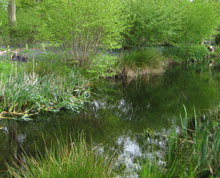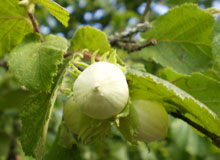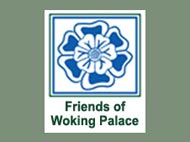Brief History of Woking Palace
Woking Palace was not only a palace, but also in effect the manor house of the old Royal Manor of Woking, which was roughly the same date as the ancient parish of St Peterís, Woking, excluding the smaller manors of Sutton and Bridley.
The Palace stood in a park the boundaries of which were roughly the present day Old Woking Road, Pyrford Common Road, Church Hill and Newark Lane with the River Wey as its southern boundary. The area between the river and the River Wey Navigation known as Broadmead was, in effect, Wokingís Lammas field. Broadmead now forms part of a Site of Special Scientific Interest.
A manor house was recorded on the site in 1272. The manor passed through various owners, including the Bassetts and Despensers, the Hollands and the Kents and the Beauforts. Lady Margaret Beaufort, the mother of Henry VII, lived in the house from 1466 until at least 1471.
'The Kingís Mother', by Michael K. Jones and Malcolm Underwood and published by Cambridge University Press, is the definitive work on Lady Margaret Beaufort. Surrey Libraries have two copies, one at Guildford and the other at Woking. In addition, Surrey History Centre have a reference copy.
The Palace was frequently visited by Henry VII on his accession to the throne, and by his son Henry VIII, who extended and enlarged the Palace between 1515 and 1543. The royal residence at Woking Palace consisted of a great hall and extensive ancilliary buildings within a double moat, and was used by royalty during the Tudor period. It was a royal hunting lodge or quasi-palace surrounded by parkland.
Throughout Henry VIII's reign, the manor house underwent regular maintenance as well as some alterations. Additions approved by Henry VIII included a new wharf by the river and two new bowling alleys. Maintenance works included the replacement of bridge planks, alterations to room partitions, plastering and painting, replacement of glass in the windows, retiling of roofs and fireplaces, and the installation of new windows. Henry also had new kitchens built adjoining the Great Hall, and apartments for the king and queen. All of Henry's queens visited the Palace and would have enjoyed the excellent hunting in the park.
Queen Mary did not visit the Palace, but further work was carried out between 1565 and 1594 during Elizabeth Iís reign.
In 1620, the Palace was granted by James I to Sir Edward Zouch who abandoned it and built himself a new manor house at Hoe Place. There is some evidence that materials from the Palace were reused in the construction of the new house. It is possible too, that some of the fine glass at Sutton Place was taken from the Palace and the Jacobean style staircase at Fishers Farm may well have originated from the same source.
By the reign of Charles II, the palace appears to have been abandoned and virtually ruined and the Park was turned over to farming. This new phase probably gave rise to the building of farmhouses in the Park or the conversion of existing buildings to such use. The Old House and Woking Park Farm were probably two of those farmhouses.
Read about the connection between the history of the Royal Manor of Woking and the Woking Coat of Arms.
For information on Henry VIIIís neighbouring house, Chobham Park, go to www.chobham.info/chobham_park_2.htm.

One of the fishponds in the copse |

Hazel nuts ripening in the copse |





